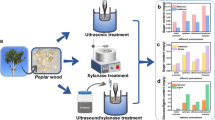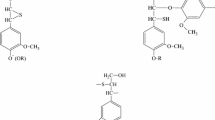Abstract
Alkali treatment was used to increase the reactivity of birch kraft pulp prior to its 2,2,6,6-tetramethyl-1-piperidinyloxy (TEMPO) catalyzed oxidation with hypochlorite, which is a process commonly applied to prepare nanofibrillated cellulose. On contrary to the traditional use of NaBr as a cocatalyst, TEMPO was activated with HOCl prior to the oxidation. Commonly, the lack of bromide increases the oxidation time and impairs the formation of carboxylic groups. However, the reaction time of the bromide-free TEMPO catalyzed oxidation could be shortened from 2.5 to 0.5 h when the pulp was treated with 1 M NaOH prior to the oxidation (2.4 mmol NaOCl/g pulp). The beneficial effect was obtained even if the alkali treatment was executed at room temperature and only for few minutes. Moreover, the alkali pretreatment enabled selective production of a pulp with carboxylate content as high as 1.6 mmol/g with NaOCl dosage of 4.4 mmol/g. The changes in the cellulosic raw material during the alkali treatment were assessed by water retention value and carbohydrate analysis.





Similar content being viewed by others
References
Ambjörnsson HA, Schenzel K, Germgård U (2013) Carboxymethyl cellulose produced at different mercerization conditions and characterized by NIR FT Raman spectroscopy in combination with multivariate analytical methods. Bioresources 8:1918–1932
Besbes I, Alila S, Boufi S (2011) Nanofibrillated cellulose from TEMPO-oxidized eucalyptus fibres: effect of the carboxyl content. Carbohydr Polym 84:975–983
Borysiak S, Doczekalska B (2008) Research into the mercerization process of beechwood using waxs method. Fibres Text 16:101–103
Bowman MJ, Dien BS, O´Bryan PJ, Sarath G (2011) Selective chemical oxidation and depolymerzation of switchgrass (Panicum vigratum L.) xylan with oligosaccharide product analysis by mass spectrometry. Rapid Commun Mass Spectrom 25:941–950
Bragd PL, Besemer AC, van Bekkum H (2000) Bromide-free TEMPO-mediated oxidation of primary alcohol groups in starch and methyl alpha-D-glucopyranoside. Carbohydr Res 328:355–363
Bragd PL, Besemer AC, Bekkum HV (2001) TEMPO-derivatives as catalysts in the oxidation of primary alcohol groups in carbohydrates. J Mol Catal A: Chem 70:35–42
Bragd PL, van Bekkum H, Besemer AC (2004) TEMPO-mediated oxidation of polysaccharides: survey of methods and applications. Top Catal 27:49–66
Brodin FW, Theliander H (2013) A comparison of softwood and birch kraft pulp fibers as raw materials for production of TEMPO-oxidized pulp, MFC and superabsorbent foam. Cellulose 20:2825–2838
Bulota M, Tanpichai S, Hughes M, Eichhorn SJ (2011) Micromechanics of TEMPO-oxidized fibrillated cellulose composites. ACS Appl Mater Interfaces 4:331–337
Crawshaw J, Bras W, Mant GR, Cameron RE (2002) Simultaneous SAXS and WAXS investigations of changes in native cellulose fiber microstructure on swelling in aqueous sodium hydroxide. J Appl Polym Sci 83:1209–1218
de Nooy AEJ, Besemer AC, van Bekkum H (1995a) Highly selective nitroxyl radical-mediated oxidation of primary alcohol groups in water-soluble glucans. Carbohydr Res 269:89–98
de Nooy AEJ, Besemer AC, van Bekkum H (1995b) Selective oxidation of primary alcohols mediated by nitroxyl radical in aqueous solution. Tetrahedron 51:8023–8032
Dinand E, Vignon M, Chanzy H, Heux L (2002) Mercerization of primary wall cellulose and its implication for the conversion of cellulose I → cellulose II. Cellulose 9:7–18
El-Din NMS (1993) The water retention values of never-dried alkali-treated celluloses. Polym Int 32:13–17
Fujisawa S, Ikeuchi T, Takeuchi M, Saito T, Isogai A (2012) Superior reinforcement effect of TEMPO-oxidized cellulose nanofibrils in polystyrene matrix: optical, thermal, and mechanical studies. Biomacromolecules 13:2188–2194
Higgins HG, McKenzie AW (1963) The structure and properties of paper XIV. Effects of drying on cellulose fibres and the problem of maintaining strength. Appita 16:145–164
Hirota M, Tamura N, Saito T, Isogai A (2009) Oxidation of regenerated cellulose with NaClO2 catalyzed by TEMPO and NaClO under acid-neutral conditions. Carbohydr Polym 78:330–335
Ibert M, Marsais F, Merbouh N, Brückner C (2002) Determination of the side-products formed during the nitroxide-mediated bleach oxidation of glucose to glucaric acid. Carbohydr Res 337:1059–1063
Isogai A (2011a) TEMPO-oxidized cellulose nanofibers. Nanoscale 3:71–85
Isogai T (2011b) Wood cellulose nanofibrils prepared by TEMPO electro-mediated oxidation. Cellulose 18:421–431
Iwamoto S, Kai W, Isogai T, Saito T, Isogai A, Iwata T (2010) Comparison study of TEMPO-analogous compounds on oxidation efficiency of wood cellulose for preparation of cellulose nanofibrils. Polym Degrad Stab 95:1394–1398
Jayme G (1944) Mikro-quellungsmessungen an zellstoffen. Wochenbl Papierfabr 6:187–194
Kitaoka T, Isogai A, Onabe F (1999) Chemical modification of pulp fibers by TEMPO-mediated oxidation. Nord Pulp Pap Res J 14:279–284
Klemm D, Philipp B, Heinze U, Heinze W (1998) Comprehensive Cellulose Chemistry, vol 1. Fundamentals and Analytical Methods, Wiley-VCH
Kljun A, Benians TAS, Goubet F, Meulewaeter F, Knox JP, Blackburn RS (2011) Comparative analysis of crystallinity changes in cellulose I polymers using ATR-FTIR, X-ray diffraction, and carbohydrate-binding module probes. Biomacromolecules 12:4121–4126
Klungness JH (1974) Recycled fiber properties as affected by contaminants and removal processes. Tappi 57:71–75
Lai C, Sheng L, Liao S, Xi T, Zhang Z (2013) Surface characterization of TEMPO-oxidized bacterial cellulose. Surf Interface Anal 45:1673–1679
Lehtimaa T, Kuitunen S, Tarvo V, Vuorinen T (2010) Kinetics of aldehyde oxidation by chlorous acid. Ind Eng Chem Res 49:2688–2693
Liaigre D, Breton T, Belgsir EM (2005) Kinetic and selectivity control of TEMPO electro-mediated oxidation of alcohols. Electrochem Commun 7:312–316
Lindström T (1992) Chemical factors affecting the behaviour of fibres during papermaking. Nord Pulp Pap Res J 4:181–192
Lindström T, Carlsson G (1982) The effect of carboxyl groups and their ionic form during drying on the hornification of cellulose fibers. Sven Papperstidn 85:R146–R151
Matsuda Y, Isogai A, Onabe F (1994) Effects of thermal and hydrothermal treatments on the reswelling capabilities of pulps and papersheets. J Pulp Pap Sci 20:J323–J327
McKenzie AW, Higgins HG (1958) The structure and properties of paper. Part II. The influence of alkali on the infra-red spectra, bonding capacity and beating response of wood and cotton fibres. Svensk Papperstidn 61:893–901
Mercer J (1851) Improvement in chemical processes for fulling vegetable and other textures. US Patent 8303
Mozdyniewicz DJ, Nieminen K, Sixta H (2013) Alkaline steeping of dissolving pulp. Part I: cellulose degredation kinetics. Cellulose 20:1437–1451
Müller M, Czihak C, Schober H, Nishiyama Y, Vogl G (2000) All disordered regions of native cellulose show common low-frequency dynamics. Macromolecules 33:1834–1840
Newman RH (2004) Carbon-13 NMR evidence for cocrystallization of cellulose as a mechanism for hornification of bleached kraft pulp. Cellulose 11:45–52
Okita Y, Saito T, Isogai A (2009) TEMPO-mediated oxidation of softwood thermomechanical pulp. Holzforschung 63:529–535
Okita Y, Saito T, Isogai A (2010) Entire surface oxidation of various cellulose microfibrils by TEMPO-mediated oxidation. Biomacromolecules 11:1696–1700
Pejik BM, Kostic MM, Scundric PD, Praskalo PZ (2008) The effects of hemicelluloses and lignin removal on water uptake behavior of hemp fibers. Bioresour Technol 99:7152–7159
Philipp B, Lehmann R, Ruscher C (1959) Zum Einfluß des Cellulosematerials auf den Verlauf der Alkalicellulosebildung. Faserforschung und Textiltechnik 10:22–35
Porro F, Bedue O, Chanzy H, Heux L (2007) Solid-state 13C NMR study of na-cellulose complexes. Biomacromolecules 8:2586–2593
Rodionova G, Saito T, Lenes M, Eriksen O, Gregersen O, Kuramae R, Isogai A (2013) TEMPO-mediated oxidation of norway spruce and eucalyptus pulps: preparation and characterization of nanofibers and nanofiber dispersions. J Polym Environ 21:207–214
Saito G (1939) Das Verhalten der Zellulose in Alkalilösungen. Kolloid-Beih 49:365–454
Saito T, Isogai A (2004) TEMPO-mediated oxidation of native cellulose. the effect of oxidation conditions on chemical and crystal structures of the water-insoluble fractions. Biomacromolecules 5:1983–1989
Saito T, Nishiyama Y, Putaux J, Vignon M, Isogai A (2006) Homogeneous suspensions of individualized microfibrils from TEMPO-catalyzed oxidation of native cellulose. Biomacromolecules 7:1687–1691
Saito T, Kimura S, Nishiyama Y, Isogai A (2007) Cellulose nanofibers prepared by TEMPO-mediated oxidation of native cellulose. Biomacromolecules 8:2485–2491
Saito T, Hirota M, Tamura N, Kimura S, Fukuzumi H, Heux L et al (2009) Individualization of nano-sized plant cellulose fibrils by direct surface carboxylation using TEMPO catalyst under neutral conditions. Biomacromolecules 10:1992–1996
Saito T, Hirota M, Tamura N, Isogai A (2010) Oxidation of bleached wood pulp by TEMPO/NaClO/NaClO2 system: effect of the oxidation conditions on carboxylate content and degree of polymerization. J Wood Sci 56:227–232
Schwabe K, Philipp B (1954) Zur Kinetik von Dampfsorption, Quellung und Flüssigkeitsaufsaugung der Zellulose. Holzforschung 8:1–12
Schwabe K, Philipp B (1955) Zur Umsetzung von Cellulose mit Tetraäthylammoniumhydroxyd. Holzforschung 9:104–109
Sjöström E, Enström B (1967) Characterization of acidic polysaccharides isolated from different pulps. Tappi 50:32–36
Sluiter A, Hames B, Ruiz R, Scarlata C, Sluiter J, Templeton D, Crocker D (2011) Determination of Structural Carbohydrates and Lignin in Biomass. National Renewable Energy Laboratory, Golden
Sun B, Gu C, Ma J, Liang B (2005) Kinetic study on TEMPO-mediated selective oxidation of regenerated cellulose. Cellulose 12:59–66
Tanaka R, Saito T, Isogai A (2012) Cellulose nanofibrils prepared from softwood cellulose by TEMPO/NaClO/NaClO2systems in water at pH 4.8 or 6.8. Int J Biol Macromol 51:228–234
Van de Weyenberg I, Chi Truong T, Vangrimde B, Verpoest I (2006) Improving the properties of UD flax fibre reinforced composites by applying an alkaline fibre treatment. Compos A 37:1368–1376
Wadsworth LC, Cuculo JA, Hudson SM (1979) A comparison of the effects of liquid ammonia and sodium hydroxide treatments on the accessibility of wood pulp. Text Res J 49:424–427
Wartiovaara I (1982) The influence of pH on the D1 stage of a D/CED1 bleaching sequence. Pap Puu 64:534–545
Watanabe E, Tamura N, Saito T, Habu N, Isogai A (2012) Preparation of completely C6-carboxylated curdlan by catalytic oxidation with 4-acetamido-TEMPO. Carbohydr Polym 100:74–79
Weise U, Hiltunen E, Paulapuro H (1998) Verhornung von Zellstoff und Maßnahmen zu ihrer Reversion. Das Papier 52:V14–V19
Zhao M (1999) Oxidation of primary alcohols to carboxylic acids with sodium chlorite catalyzed by TEMPO and bleach. J Org Chem 64:2564–2566
Acknowledgments
This study was supported by UPM Nanocenter and TEKES as a part of Nanocellulose IV project. We thank Mrs Mirja Reinikainen and Ms Kristel Kosk for excellent laboratory work.
Author information
Authors and Affiliations
Corresponding author
Rights and permissions
About this article
Cite this article
Pönni, R., Pääkkönen, T., Nuopponen, M. et al. Alkali treatment of birch kraft pulp to enhance its TEMPO catalyzed oxidation with hypochlorite. Cellulose 21, 2859–2869 (2014). https://doi.org/10.1007/s10570-014-0278-3
Received:
Accepted:
Published:
Issue Date:
DOI: https://doi.org/10.1007/s10570-014-0278-3




